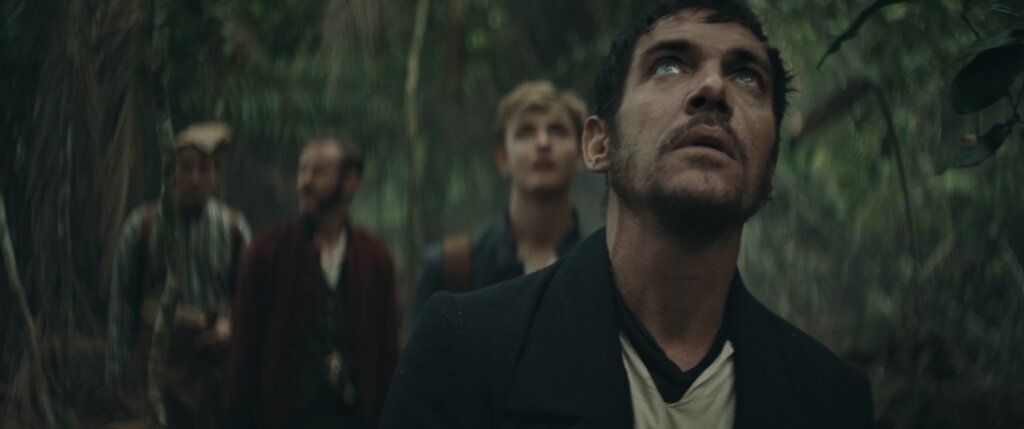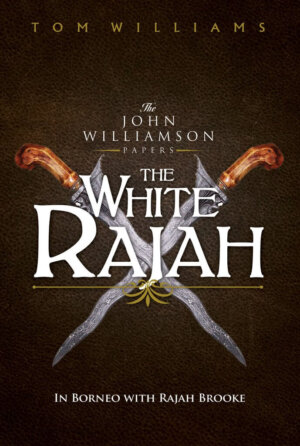Last week’s blog post brought us up to the point where the new film, Edge of the World, picks up the story of James Brooke.
Edge of the World has Brooke’s party landing rather randomly in Borneo and promptly being captured by a party of native Dyaks.

In fact, Brooke arrived in Kuching, the capital of the province of Sarawak, where (as we learned last week) he knew he would find the de facto ruler of Borneo, Muda Hassim.
Hassim was in Sarawak, rather than his capital, because of a long-running uprising there.
The politics of Borneo in the mid-19th century were Byzantine. Power was held by Malays. The indigenous people – the Dyaks – were relatively powerless. When Brooke arrived in Sarawak, Hassim was occupied in putting down a rising, of Dyaks, who were supported by a faction within the Malay community – the Siniawan Malays. In fact, they were almost certainly supported by elements within the Malay court who were trying to reduce Hassim’s power. By now the uprising had been going on for four years. Hassim had been in Sarawak for months and nothing seemed to have changed since he moved his court there. Hassim saw Brooke’s arrival as providential.

Brooke had taken on additional crew in Singapore (including an interpreter called John Williamson, whose name I stole for the narrator in The White Rajah). Brooke now had a crew of 28 men on board the Royalist. Hassim looked at her six cannon and the White Ensign hanging at her mast and saw her as a symbol of British power. If he could get Brooke involved in the war, he thought he could finally bring things to a conclusion and return to the seat of power in Brunei.
At first, Brooke refused to get drawn in. In the end, though, the temptation was irresistible. Here was a chance for excitement and adventure which could be economically justified as improving his trade prospects and which also appealed to his patriotism as it would strengthen the British presence in the region and put one in the eye to the Dutch. Here is Brooke’s own account of his attitude to intervening in what was, effectively, a civil war in Borneo.
I may here state my motives for being a spectator at all, or participator (as may turn out), in this scene. In the first place, I must confess that curiosity strongly prompted me; since to witness the Malays, Chinese [yes, there were Chinese too, immigrants who essentially monopolised trade], and Dayaks in warfare was so new, that the novelty alone might plead an excuse for this desire. But it was not the only motive; for my presence is a stimulus to our own party, and will probably depress the other in proportion. I look upon the cause of the Raja [Hassim] as most just and righteous; and the speedy close of the war will be rendering a service to humanity, especially if brought about by treaty.
Brooke provided advice and encouragement to Hassim and finally, when things seemed likely to drag on even with his urging Hassim to attack more vigorously, he sent for two of his six-pounder guns and some of his men to be despatched from the Royalist to the front-line (for want of a better word) at a place called Balidah, just upriver from Kuching. Within days of their arrival, the rebel defences were breached, but Hassim’s army refused to storm the breach. Brooke, despairing of any end to the fighting, made plans to return to Singapore.
His diary tells what happened next:
I explained to [Hassim] how useless it was my remaining and intimated to him my intention of departing; but his deep regret was so visible, that even all the self-command of the native could not disguise it. He begged, he entreated me to stay, and offered me the country of Siniawan and Sarawak, and its government and trade, if I would only stop, and not desert him.
Brooke did not immediately accept this offer but he did decide to stay and support Hassim’s efforts in the war, where the men of the Royalist soon proved decisive.
With the war over, Hassim vacillated on his promise to make Brooke ruler, but ultimately he seems to have felt that the benefits of retaining Brooke’s support were worth the cost of allowing him to govern a province which Hassim regarded as not that important and which probably, because of the insurrection, seemed more trouble than it was worth. He may also have considered that having the province under the control of an Englishman would offer some sort of protection against Dutch expansionism. He will certainly have considered that it might bolster his own position in the intrigues between himself and other powerful Malay factions.

Negotiations dragged on for almost a year with Brooke often threatening to sail away and leave Hassim to his own devices. Eventually, though,Hassim drew up and signed a document giving Brooke the government of Sarawak and on 24 November 1841 he was ceremoniously declared Rajah.

The White Rajah
The White Rajah is a fictionalised account of the true story I’ve outlined above. It tells how Brooke came to rule Sarawak and something of what happened afterwards.
British colonialism (though Brooke’s personal kingdom was never technically a colony) was neither the unmitigated good that it was presented as up until the late 20th century, nor the straightforwardly exploitationist affair that we are often told it was nowadays. The White Rajah tries to tell a good tale while exploring some of the moral nuances of the Age of Empire.
The White Rajah is available in hardback for £14.99. You can also buy it in paperback for £6.99 or, if you prefer Kindle, just £3.99.
